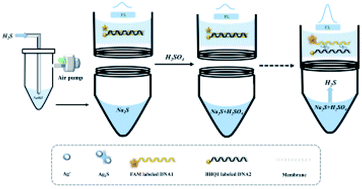当前位置:
X-MOL 学术
›
Anal. Methods
›
论文详情
Our official English website, www.x-mol.net, welcomes your
feedback! (Note: you will need to create a separate account there.)
A signal-on fluorescence sensor for hydrogen sulphide detection in environmental samples based on silver-mediated base pairs
Analytical Methods ( IF 2.7 ) Pub Date : 2019-11-29 , DOI: 10.1039/c9ay02232e Yanling Huang 1, 2, 3, 4, 5 , Guiyin Yue 1, 2, 3, 4, 5 , Fang Luo 4, 5, 6, 7 , Longhua Guo 1, 2, 3, 4, 5 , Bin Qiu 1, 2, 3, 4, 5 , Zhenyu Lin 1, 2, 3, 4, 5
Analytical Methods ( IF 2.7 ) Pub Date : 2019-11-29 , DOI: 10.1039/c9ay02232e Yanling Huang 1, 2, 3, 4, 5 , Guiyin Yue 1, 2, 3, 4, 5 , Fang Luo 4, 5, 6, 7 , Longhua Guo 1, 2, 3, 4, 5 , Bin Qiu 1, 2, 3, 4, 5 , Zhenyu Lin 1, 2, 3, 4, 5
Affiliation

|
Hydrogen sulfide (H2S) is a dramatically toxic gas molecule; long term exposure to H2S environment poses a serious threat to human health. It is highly imperative to develop sensitive and selective methods for H2S detection. In this study, a signal-on fluorescence biosensor for the H2S (used to represent the total amount of H2S, HS− and S2−) detection was developed based on silver-mediated base pairs (C–Ag+–C). Two separate C-rich single-stranded DNAs (ssDNAs) were synthesized, namely, one was labeled with fluorescein (6-carboxyfluorescein, FAM) and the other was labeled with quencher (black hole quencher, BHQ1). The two ssDNAs were in a flexible single strand owing to the mismatch of the ssDNA, and hence, significant fluorescence intensity was observed. In the presence of Ag+, DNA probes could selectively capture Ag+ to form double stranded DNA (dsDNA) via the C–Ag+–C base pairs, which made the quench of FAM by BHQ1 and low fluorescence signal was detected. With the addition of H2S to the system, the dsDNA was decomposed into ssDNA since Ag+ could be released from C–Ag+–C by the formation of a more stable complex Ag2S, which resulted in the recovery of the fluorescence intensity. The enhanced fluorescence intensity had a linear relationship with H2S concentration in the range from 0.5 to 20 μM with a detection limit (LOD) of 0.16 μM (S/N = 3). The proposed system was applied to detect H2S (used to represent the total amount of H2S, HS− and S2−) in air near a garbage station with satisfying results.
中文翻译:

一种基于信号的荧光传感器,用于基于银介导的碱基对的环境样品中的硫化氢检测
硫化氢(H 2 S)是一种剧毒的气体分子。长期暴露于H 2 S环境会对人类健康构成严重威胁。开发灵敏和选择性的H 2 S检测方法非常必要。在这项研究中,信号荧光生物传感器对H 2 S(用于表示H的总量2 S,HS -和S 2-)检测是基于开发银介导的碱基对(C-的Ag +-C)。合成了两个单独的富含C的单链DNA(ssDNA),即一个被荧光素标记(6-羧基荧光素,FAM),另一个被淬灭剂标记(黑洞淬灭剂,BHQ1)。由于ssDNA的不匹配,两个ssDNA处于柔性单链中,因此观察到显着的荧光强度。在存在Ag +的情况下,DNA探针可以通过C–Ag + –C碱基对选择性地捕获Ag +形成双链DNA(dsDNA),这使得BHQ1可以猝灭FAM,并检测到低荧光信号。在系统中添加H 2 S后,dsDNA分解为ssDNA,因为Ag +可能从C–Ag +中释放出来。-C通过形成更稳定的复合物Ag 2 S导致荧光强度的恢复。增强的荧光强度与H 2 S浓度在0.5至20μM范围内具有线性关系,检测极限(LOD)为0.16μM(S / N = 3)。所提出的系统应用于检测ħ 2 S(用于表示H的总量2 S,HS -和S 2-)与满足的结果在空气中附近的垃圾站。
更新日期:2020-01-02
中文翻译:

一种基于信号的荧光传感器,用于基于银介导的碱基对的环境样品中的硫化氢检测
硫化氢(H 2 S)是一种剧毒的气体分子。长期暴露于H 2 S环境会对人类健康构成严重威胁。开发灵敏和选择性的H 2 S检测方法非常必要。在这项研究中,信号荧光生物传感器对H 2 S(用于表示H的总量2 S,HS -和S 2-)检测是基于开发银介导的碱基对(C-的Ag +-C)。合成了两个单独的富含C的单链DNA(ssDNA),即一个被荧光素标记(6-羧基荧光素,FAM),另一个被淬灭剂标记(黑洞淬灭剂,BHQ1)。由于ssDNA的不匹配,两个ssDNA处于柔性单链中,因此观察到显着的荧光强度。在存在Ag +的情况下,DNA探针可以通过C–Ag + –C碱基对选择性地捕获Ag +形成双链DNA(dsDNA),这使得BHQ1可以猝灭FAM,并检测到低荧光信号。在系统中添加H 2 S后,dsDNA分解为ssDNA,因为Ag +可能从C–Ag +中释放出来。-C通过形成更稳定的复合物Ag 2 S导致荧光强度的恢复。增强的荧光强度与H 2 S浓度在0.5至20μM范围内具有线性关系,检测极限(LOD)为0.16μM(S / N = 3)。所提出的系统应用于检测ħ 2 S(用于表示H的总量2 S,HS -和S 2-)与满足的结果在空气中附近的垃圾站。











































 京公网安备 11010802027423号
京公网安备 11010802027423号